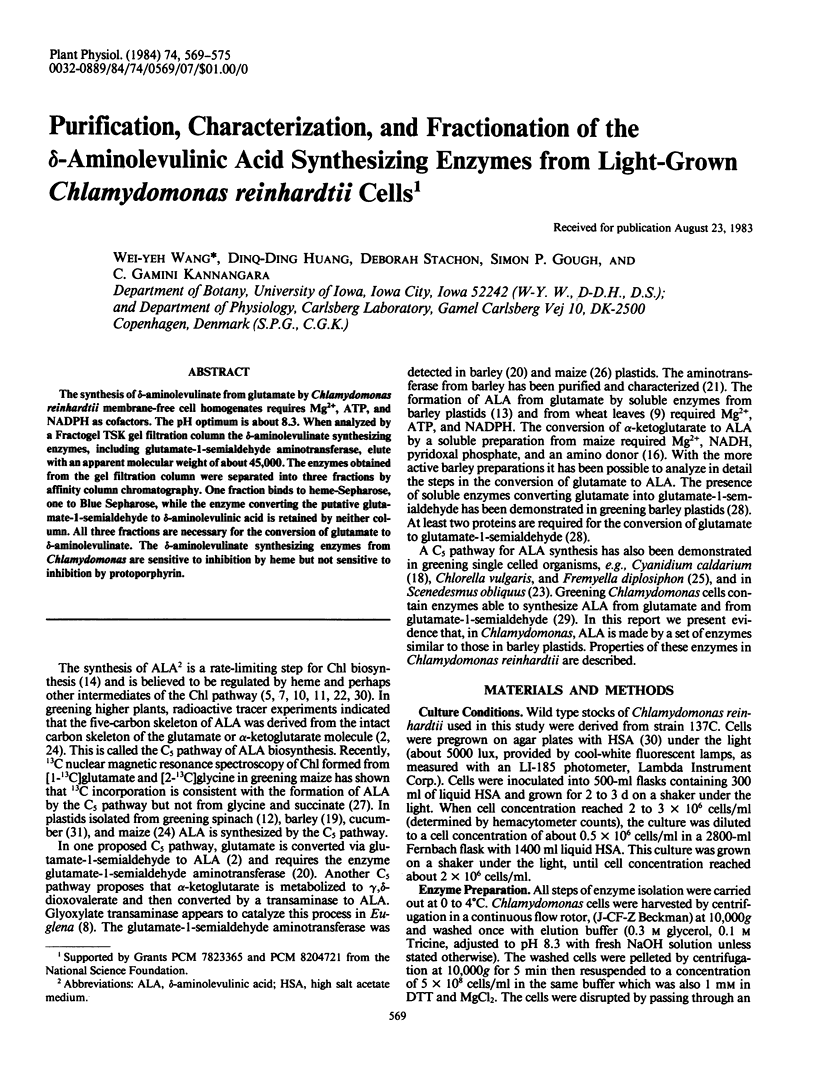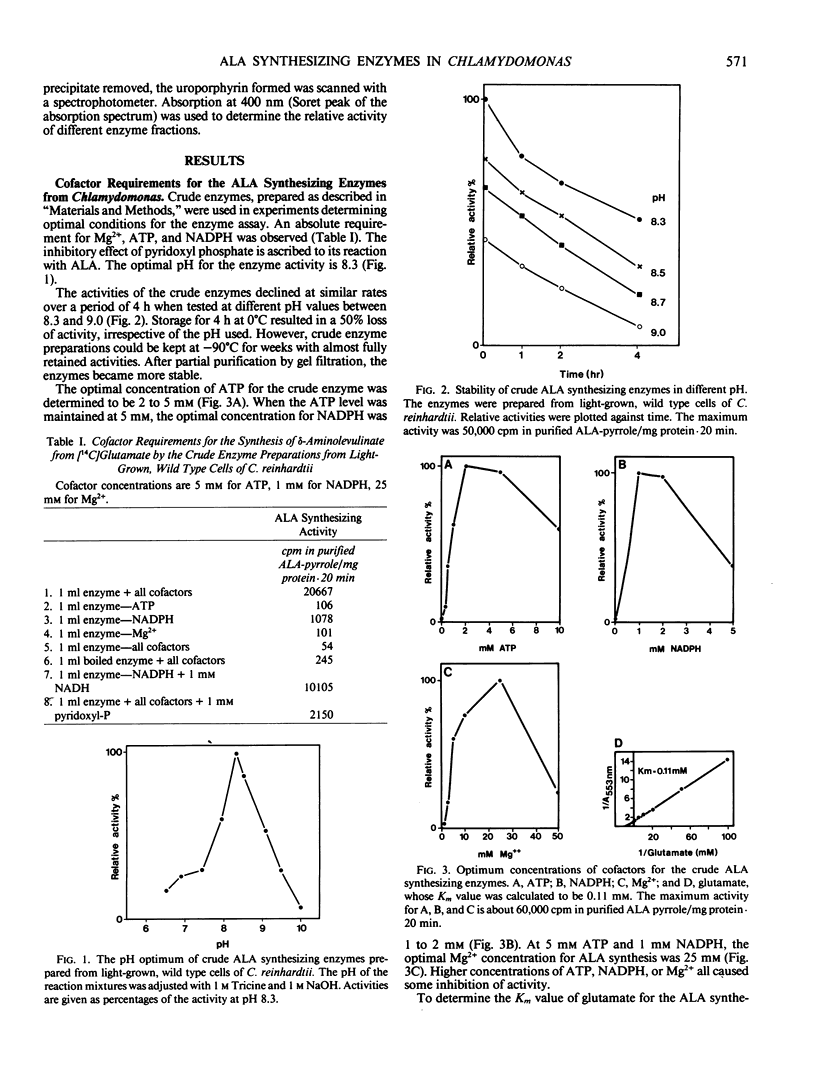Abstract
The synthesis of δ-aminolevulinate from glutamate by Chlamydomonas reinhardtii membrane-free cell homogenates requires Mg2+, ATP, and NADPH as cofactors. The pH optimum is about 8.3. When analyzed by a Fractogel TSK gel filtration column the δ-aminolevulinate synthesizing enzymes, including glutamate-1-semialdehyde aminotransferase, elute with an apparent molecular weight of about 45,000. The enzymes obtained from the gel filtration column were separated into three fractions by affinity column chromatography. One fraction binds to heme-Sepharose, one to Blue Sepharose, while the enzyme converting the putative glutamate-1-semialdehyde to δ-aminolevulinic acid is retained by neither column. All three fractions are necessary for the conversion of glutamate to δ-aminolevulinate. The δ-aminolevulinate synthesizing enzymes from Chlamydomonas are sensitive to inhibition by heme but not sensitive to inhibition by protoporphyrin.
Full text
PDF






Selected References
These references are in PubMed. This may not be the complete list of references from this article.
- Beale S. I., Gough S. P., Granick S. Biosynthesis of delta-aminolevulinic acid from the intact carbon skeleton of glutamic acid in greening barley. Proc Natl Acad Sci U S A. 1975 Jul;72(7):2719–2723. doi: 10.1073/pnas.72.7.2719. [DOI] [PMC free article] [PubMed] [Google Scholar]
- Beale S. I. Studies on the Biosynthesis and Metabolism of delta-Aminolevulinic Acid in Chlorella. Plant Physiol. 1971 Sep;48(3):316–319. doi: 10.1104/pp.48.3.316. [DOI] [PMC free article] [PubMed] [Google Scholar]
- Bradford M. M. A rapid and sensitive method for the quantitation of microgram quantities of protein utilizing the principle of protein-dye binding. Anal Biochem. 1976 May 7;72:248–254. doi: 10.1016/0003-2697(76)90527-3. [DOI] [PubMed] [Google Scholar]
- CLELAND W. W. DITHIOTHREITOL, A NEW PROTECTIVE REAGENT FOR SH GROUPS. Biochemistry. 1964 Apr;3:480–482. doi: 10.1021/bi00892a002. [DOI] [PubMed] [Google Scholar]
- Castelfranco P. A., Jones O. T. Protoheme turnover and chlorophyll synthesis in greening barley tissue. Plant Physiol. 1975 Mar;55(3):485–490. doi: 10.1104/pp.55.3.485. [DOI] [PMC free article] [PubMed] [Google Scholar]
- Duggan J., Gassman M. Induction of porphyrin synthesis in etiolated bean leaves by chelators of iron. Plant Physiol. 1974 Feb;53(2):206–215. doi: 10.1104/pp.53.2.206. [DOI] [PMC free article] [PubMed] [Google Scholar]
- Foley T., Beale S. I. delta-Aminolevulinic Acid Formation from gamma,delta-Dioxovaleric Acid in Extracts of Euglena gracilis. Plant Physiol. 1982 Nov;70(5):1495–1502. doi: 10.1104/pp.70.5.1495. [DOI] [PMC free article] [PubMed] [Google Scholar]
- Ford S. H., Friedmann H. C. Formation of delta-aminolevulinic acid from glutamic acid by a partially purified enzymes system from wheat leaves. Biochim Biophys Acta. 1979 Aug 15;569(2):153–158. doi: 10.1016/0005-2744(79)90050-0. [DOI] [PubMed] [Google Scholar]
- Gough S. Defective synthesis of porphyrins in barley plastids caused by mutation in nuclear genes. Biochim Biophys Acta. 1972 Nov 24;286(1):36–54. doi: 10.1016/0304-4165(72)90086-4. [DOI] [PubMed] [Google Scholar]
- Granick S., Sassa S., Granick J. L., Levere R. D., Kappas A. Assays for porphyrins, delta-aminolevulinic-acid dehydratase, and porphyrinogen synthetase in microliter samples of whole blood: applications to metabolic defects involving the heme pathway. Proc Natl Acad Sci U S A. 1972 Sep;69(9):2381–2385. doi: 10.1073/pnas.69.9.2381. [DOI] [PMC free article] [PubMed] [Google Scholar]
- Harel E., Ne'eman E. Alternative Routes for the Synthesis of 5-Aminolevulinic Acid in Maize Leaves : II. Formation from Glutamate. Plant Physiol. 1983 Aug;72(4):1062–1067. doi: 10.1104/pp.72.4.1062. [DOI] [PMC free article] [PubMed] [Google Scholar]
- Jurgenson J. E., Beale S. I., Troxler R. F. Biosynthesis of delta-aminolevulinic acid in the unicellular rhodophyte, cyanidium caldarium. Biochem Biophys Res Commun. 1976 Mar 8;69(1):149–157. doi: 10.1016/s0006-291x(76)80285-9. [DOI] [PubMed] [Google Scholar]
- Klein O., Senger H. Two Biosynthetic Pathways to delta-Aminolevulinic Acid in a Pigment Mutant of the Green Alga, Scenedesmus obliquus. Plant Physiol. 1978 Jul;62(1):10–13. doi: 10.1104/pp.62.1.10. [DOI] [PMC free article] [PubMed] [Google Scholar]
- Porra R. J., Klein O., Wright P. E. The proof by 13C-NMR spectroscopy of the predominance of the C5 pathway over the Shemin pathway in chlorophyll biosynthesis in higher plants and of the formation of the methyl ester group of chlorophyll from glycine. Eur J Biochem. 1983 Feb 15;130(3):509–516. doi: 10.1111/j.1432-1033.1983.tb07179.x. [DOI] [PubMed] [Google Scholar]
- Wang W. Y., Wang W. L., Boynton J. E., Gillham N. W. Genetic control of chlorophyll biosynthesis in Chlamydomonas. Analysis of mutants at two loci mediating the conversion of protoporphyrin-IX to magnesium protoporphyrin. J Cell Biol. 1974 Dec;63(3):806–823. doi: 10.1083/jcb.63.3.806. [DOI] [PMC free article] [PubMed] [Google Scholar]
- Weinstein J. D., Castelfranco P. A. Mg-protoporphyrin-IX and delta-aminolevulinic acid synthesis from glutamate in isolated greening chloroplasts. delta-Aminolevulinic acid sysnthesis. Arch Biochem Biophys. 1978 Mar;186(2):376–382. doi: 10.1016/0003-9861(78)90448-4. [DOI] [PubMed] [Google Scholar]
- de la Roche A. I. Increase in linolenic Acid is not a prerequisite for development of freezing tolerance in wheat. Plant Physiol. 1979 Jan;63(1):5–8. doi: 10.1104/pp.63.1.5. [DOI] [PMC free article] [PubMed] [Google Scholar]


